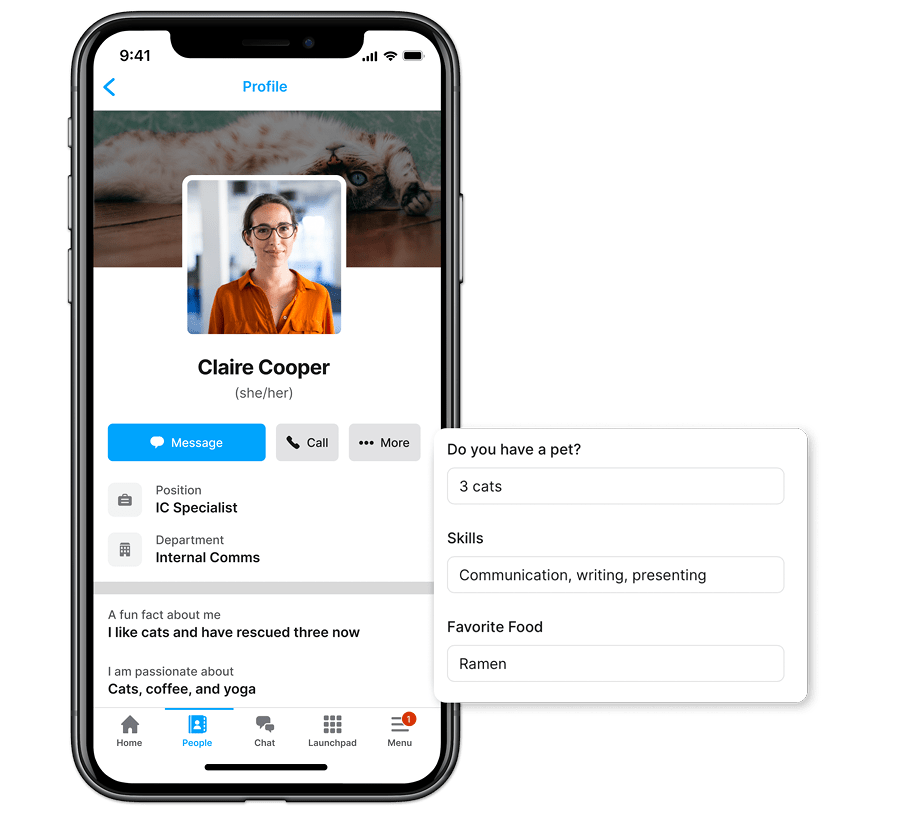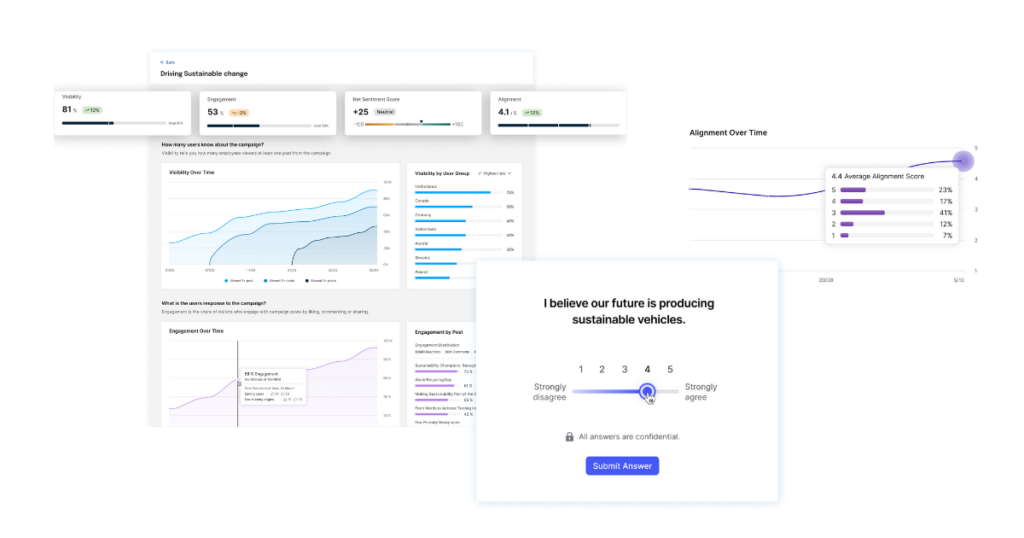Is an Enterprise Social Network the Best Tool for Your Organization?

Enterprise social networks (ESNs) like Yammer and Jabber first hit the scene in the 2000s and early 2010s — but are they still fit for purpose? In this article, we explore everything there is to know about enterprise social networks, including their benefits, key features, use cases, and more. We’ll also discuss some of the downsides of ESNs (and what you could use instead).
What is an enterprise social network?
An enterprise social network (ESN) is a private, internal platform that enables employees to communicate and collaborate. These tools foster informal conversations among colleagues, as well as acting as a space for collaboration on important tasks and projects. ESNs are particularly valuable in the remote era because they allow employees to forge connections with their colleagues despite the physical distance between them.
Enterprise social networks (or enterprise social intranets) are not a new concept. One of the first big names in the space was Yammer, which was launched in 2008 and acquired by Microsoft in 2012. In the same year, a McKinsey survey revealed that 72% of companies were already using social technologies in one way or another.
These days, there are many different enterprise social network platforms available, all of which come with their own unique feature sets. However, most share a core set of functionalities like news feeds, user-generated content, and private and group messaging. The most effective ESNs also integrate seamlessly with other popular work tools, including communication platforms, productivity suites, and HR systems.
Enterprise social networks vs. social networks
Most people are familiar with traditional social media platforms like Facebook, Twitter (now X), and Instagram. As of April 2024, more than 5.07 billion people globally — over 60% of the world’s population — are reportedly active on social media.
Enterprise social networks are similar to traditional social media platforms, except that they’re private to one organization. While platforms like Facebook and LinkedIn allow users to connect and communicate with anyone, an ESN provides a secure, exclusive space for your company’s employees.
Enterprise social platforms may also have additional features that make them better suited for work communications. For example, they may include integrations with other popular work tools, or special features designed to enhance collaboration and boost productivity.
How do enterprise social networks work?
Like traditional social media platforms, enterprise social networks are places where people can share content including text, images, and videos. Other people can then “like” or comment on that content, and choose to share it with their own networks. Different enterprise social media networks have their own unique functionalities, but most of them allow employees to “follow” others and join groups and communities that are relevant to them. Their personal activity feed is then populated with content from their groups and connections, as well as company-wide announcements.
Many enterprise social networks have additional features like individual and group instant messaging and even spaces for collaboration. Some platforms also have built-in knowledge repositories and the capacity for document management, though this is less common. Companies often need to pair their enterprise social network with another tool to fully address their document management and collaboration needs.

5 benefits of enterprise social networks
An enterprise social network can have a lot of advantages for an organization, especially when it’s managed effectively. Here are some of the key benefits that an ESN could bring to your company.
Drives engagement and fosters a sense of community
Employee social networks provide employees with a direct line of communication with everyone in their organization, whether that’s problem-solving with a teammate in another city or receiving a well-earned pat on the back from leadership. This is particularly valuable in large, distributed companies, where employees sometimes feel isolated and disconnected from their colleagues.
ESNs are designed to facilitate cross-functional interactions, break down organizational silos, and enable employees to give kudos to their peers for outstanding work. They also allow company leadership to share important communications with employees across all levels and locations — and even seek feedback on the company’s overall strategy and direction. This all helps each employee to feel like an integral member of a cohesive team working towards a common goal, rather than a small cog in a big machine.
Helps to maintain and enhance company culture
While an ESN can’t create a positive company culture on its own, it can play a crucial role in emphasizing and reinforcing that culture — particularly for remote employees. ESNs can also help new employees to understand and embrace the company culture, driving employee engagement from the very start of their journey with your organization.
Plus, the whole point of an ESN is to provide employees with a way of communicating with all other members of the organization, and even to connect with them on a personal level. This can lead to a more transparent, open, and inclusive culture, where employees at all levels feel seen, heard, and valued.
Streamlines communications between employees
Enterprise social networks replace lengthy email threads and inbox clutter with real-time communications. Employees can use an ESN to communicate in various ways, including:
Chatting privately with colleagues via messenger functions
Contributing to wider conversations in easy-to-understand threaded posts
Receiving important messages from leadership or HR
To maximize the effectiveness of these communications, ESNs often group employees based on their location, expertise, department, or interests. This ensures that the content employees see in their news feeds is personalized and relevant to them, which helps to keep them engaged with the platform.
Helps remote workers feel like part of the team
Although enterprise social networks have been around for more than a decade, they’re particularly relevant in the remote era. With more and more employees working at least partly from home, keeping those workers engaged and connected is a real concern. In fact, a Gallup poll from 2023 found that remote employees’ sense of connection to their organization’s mission or purpose has been declining since 2019.
One of the greatest advantages of using an ESN is the ability to bring remote workers together naturally and authentically, allowing them to foster genuine connections with their colleagues. In short, an ESN can help remote employees feel like a valued part of the team, no matter where they’re located.
Facilitates learning and knowledge sharing
In large organizations, knowledge and expertise are often siloed within specific teams or departments. An enterprise social network can help to democratize this knowledge by making it easier for employees to find answers to their questions, even if the right person to ask is miles away.
An HBR study from 2017 found that employees using a social platform were 31% more likely to find coworkers with relevant experience to help them meet job goals, and 88% more likely to identify who could put them in contact with the right person. By facilitating these connections, ESNs enable more efficient knowledge sharing and learning across the organization.
Key features of an enterprise social network
These days, companies looking to implement an enterprise social network have a wide array of solutions to choose from. While each platform offers a unique set of features and functionalities, most share some common elements. Here are a few of the main features you can expect from an ESN.
Activity feed
At the core of most enterprise social networks is an activity feed (or news feed), which is typically the first thing employees see when they log in. This is a dynamic hub where employees can browse company-wide announcements, updates from colleagues, and content from relevant groups and communities. The activity feed is designed to keep everyone informed and connected in real time.
Interaction features
Enterprise social networks are built to feel familiar to employees who are accustomed to traditional social media. That means that they typically include interaction features such as likes, comments, shares, #hashtags, and @mentions. These functions make it easy for employees to engage with content and connect with each other, fostering a collaborative environment. The fact that ESNs are designed to mirror other social media platforms means there’s typically a short learning curve for employees, which can help with adoption.
Groups and communities
Most ESNs also offer the ability to join or be automatically added to groups or communities. Often, these are divided into two categories: organizational groups based on departments, teams, locations, or projects, and more casual groups centered around employees’ personal interests. These allow employees to connect on both a professional and social level, and ensure the content that appears in each employee’s activity feed is as relevant and personalized as possible.
Employee directory
A comprehensive employee directory is another staple feature of internal enterprise social networks. Using the directory, employees can search for colleagues by team, location, skills, language, and more. Each employee typically has a profile that they can populate with their information, making it easy for others to identify and connect with the right person when they need information or assistance.

Analytics
Many ESNs come with built-in analytics features, providing admins with valuable insights into how the platform is being used. For example, they may be able to track the reach and visibility of important updates, identify which content gets the most engagement, and analyze how, when, and where employees are interacting with the platform. This enables admins to adapt the tool to employees’ needs and ensure it’s used to its full potential.
Mobile app
Most ESNs also offer a mobile app, which allows users to connect using a work or personal device. Since many of us are used to accessing social media on our phones, this can help to create a familiar and engaging experience. It can also be invaluable in helping deskless workers stay connected to the rest of the organization and up to date with the latest news from leadership.
Workplace integrations
Smooth integration with existing workplace tools is a key success factor for ESNs. For example, platforms like Staffbase’s intranet offer out-of-the-box integration with Microsoft 365, and the ability to create integrations with various HR and productivity tools through the Staffbase integration builder. This allows employees to fit the ESN seamlessly into their daily workflows, improving adoption and increasing productivity.
Bonus: AI capability
Early ESNs were populated entirely with user-generated content and official communications from HR or company leadership. But today, some solutions have evolved to include AI capabilities, which can significantly increase their impact. For example, Staffbase’s AI companion can seamlessly handle routine inquiries from employees and provide personalized content recommendations based on employee needs. This ensures that employees can quickly and easily access the information they need, without increasing the load on HR teams.
Enterprise social network use cases
Enterprise social networks can fulfill a number of different functions for an organization. Here are a few of the ways you could use an ESN.
Virtual water cooler
Whether employees are working remotely or dispersed across different global sites, an enterprise social media platform can help to bring them together. ESNs facilitate informal, authentic interactions, providing a remote alternative to the office water cooler.
By encouraging employees to chat and connect in this way, employers can help their teams build meaningful, lasting connections with their colleagues. And, given the importance of strong working relationships to overall employee satisfaction, this could have a big impact on engagement and retention over time.
Space for collaboration
Enterprise social networks can streamline collaboration by providing a centralized platform for employees to work together on tasks and projects. Instead of juggling multiple email threads and file versions, teams can collaborate in real time, in a single location. Many ESNs also offer seamless integration with productivity suites like Microsoft 365, making for even more effective collaboration.
Plus, ESNs make it easy for employees to gather feedback on important projects from a broader audience, or to seek input from specific teams or experts. With the whole organization at their fingertips, employees can easily crowdsource information, which can speed up processes and improve productivity.
Corporate communication platform
As well as encouraging information conversations, an enterprise social platform can serve as a valuable tool for corporate communications. Leadership can use the ESN to share important updates and announcements, ensuring that these messages appear directly in employees’ news feeds.
When ESNs have built-in analytics functions, admins can also track the reach and engagement of these important communications. This allows company leaders to ensure their updates reach everyone — and even gather feedback and address questions in real time. All in all, this can greatly enhance the effectiveness of organizational communication.
Hub for new employees
An ESN can be an ideal platform for onboarding new employees, particularly those working remotely. Admins or team leads can introduce new hires through posts, and get them in front of the relevant people. New hires will then be able to virtually “meet” their colleagues in the comments. Features like employee directories can also be useful in helping new employees understand who everyone is and how they fit together.
Like an employee handbook, an ESN can provide new employees with insights into the company’s culture through their colleagues’ posts and interactions. Depending on the ESN, you may also be able to upload important training and onboarding materials, so new employees can access everything they need and ask questions in the same location.
Downsides of enterprise social networks
Enterprise social networks are designed to emulate the look and feel of traditional social media platforms. This can be a big advantage, as it reduces the learning curve for employees and encourages adoption. However, this similarity is also at the heart of some of the biggest challenges companies face when introducing and maintaining ESNs.
Lack of clear purpose
Given their close resemblance to the traditional social media platforms that most of us are familiar with, employees sometimes struggle to understand the true purpose of their company ESN. Is it a crucial source of updates from the company’s leadership — or a place to share cute photos of their pets?
The truth is, an ESN is designed to serve a dual purpose, acting as both a hub for important company information and a space for casual interactions. But this can create blurred lines and leave employees unsure about what to prioritize.

Risk of information overload
Another key downside of enterprise social networks is that they can become extremely cluttered and difficult to manage. Employees can quickly become inundated with posts, messages, videos, and updates — many of which might not be relevant to them. Before long, they may disengage from the platform altogether.
And all of this noise is also the reason for another major disadvantage: key messages from leadership can easily get lost in the shuffle. When crucial company updates are thrown into an employee’s news feed alongside photos from the latest office happy hour, this can severely dilute the impact of those messages. And it doesn’t help that many ESNs come with only a limited analytics function, meaning it can be difficult for leadership to know if their communications are getting through.
Constant connectivity can impact productivity
While many proponents of ESNs claim that they improve workflows and facilitate collaboration, the truth is that they can also be a productivity drain. Like traditional social media, ESNs can be difficult to step away from — and employees may end up wasting time browsing, posting, and commenting instead of completing their work.
The constant connectivity that ESNs provide can also be a major downside. An unexpected ping from a colleague in another city looking for an answer can be derailing for employees who just want to get on with their day. And in large organizations with employees in multiple time zones, an ESN can end up putting unrealistic expectations on employees to be available 24/7 — impacting work-life balance and decreasing overall productivity.
Scalability problems in large organizations
An enterprise social network can be a fun space for employees to connect. But, once your headcount grows beyond a certain point, these platforms become increasingly unmanageable. In a large enterprise, the sheer amount of content shared by employees and managers can make it difficult for employees to find information that’s relevant to them.
Using an ESN to communicate important updates from leadership also becomes almost impossible once an organization reaches a certain size, because these messages inevitably get lost in the clutter. This is a particular concern in critical situations where crisis communications are needed since an overloaded ESN can hinder the timely spread of essential information.
Beyond enterprise social networks: transform your internal comms with an employee communication cloud
The 2012 McKinsey study quoted at the top of this article found that, while 72% of companies were already using social tools, very few were “anywhere near to achieving the full potential benefit.” McKinsey’s article claimed that technologies like internal enterprise social networks had the potential to increase the productivity of managers and high-skilled employees by 20–25%.
More than a decade later, we’re just not convinced that ESNs have lived up to that promise. So, what should large enterprises be using to get the benefits of enterprise social networks, without the downsides?
Staffbase’s Mission Control is a communication management system designed to level up internal communications and ensure crucial messaging never gets lost in the noise. With strategic topic planning and co-creation, plus analytics to track visibility, engagement, sentiment and alignment, Mission Control gives you everything you need to keep your comms on track and drive business impact.
 Measure the impact of your comms with Mission Control.
Measure the impact of your comms with Mission Control.
In short, while an employee social network can deliver big results in terms of employee engagement, this shouldn’t come at the expense of strategic communications. Using an advanced communication management system instead of relying on cluttered, noisy ESNs can help you to reach every employee and get your entire organization engaged, aligned, and working together towards a common goal.









